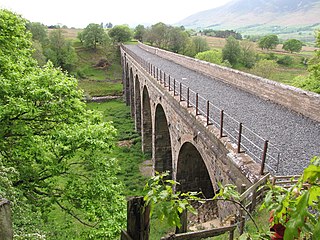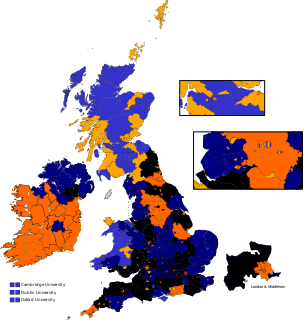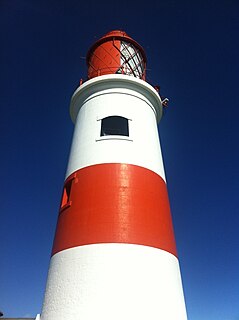
Overwater Hall is a country house near Ireby in Cumbria. It is a Grade II Listed building. [1]

Overwater Hall is a country house near Ireby in Cumbria. It is a Grade II Listed building. [1]
The house was built for Joseph Gillbanks, who had made his money in the Jamaica, in 1840 and was originally known as Whitefield House. [2] He incorporated an older 18th Century building [3] which seems to have been built by John Gaff in about 1785. The house was sold by the Gillbanks family in 1929 to Frederick Gatty, a textile merchant. [4] After Gatty's death in 1951, it was bought by Charles de Courcy-Parry, who had achieved notoriety when he shot Percy Toplis, a convicted criminal, in 1920 and who went on to become a journalist who wrote under the name of Dalesman. [4] The house was acquired by a Mr & Mrs Henry Hays in 1957, and then became a hotel owned by Mr Monte Green in 1967: it has changed hands several times since then but remains a hotel. [4]

It appears that John Gaff (1746-1794) acquired Whitefield in about 1781 when it was advertised for sale. The advertisement implies that there was a fairly modest dwelling there at this time which was owned by Mungo Simpson. A newspaper notice shows that John was living at Whitefield by 1788. [5] He died in 1794 and shortly after his son Thomas advertised the property but it appears that he did not sell it. By now the house seems to be very substantial as the notice of 1797 describes it as follows.
Thomas Gaff owned Whitefield until 1814 when he advertised it for sale. The sale notice describes the whole estate. [7] It was bought by Joseph Gillbanks. [8]
Joseph Gillbanks (1780-1853) appears to have used the existing mansion as the core of his new house in 1840. He was the son of Joseph Gillbanks (1737-1806) of Scawthwaite Close Farm near Ireby. In 1800 he went to Jamaica and over the next fourteen years he amassed a large fortune as a merchant. In 1814 he returned to England and bought Whitefield and several other large properties in the area. In 1819 he married Mary Jackson who was the daughter of Ralph Jackson of Normanby Hall in Cleveland. She was also the niece of R. Jackson, the Chief Justice of Jamaica. [9]
The couple had three children Jackson who did not marry, Mary Elizabeth who married a doctor, Richard Lawrence and Maria Josephine who married Rev. Henry Gough. Joseph became the Deputy Lieutenant for Cumberland and for almost forty years was a magistrate. [10] Joseph died in 1853 and his son Jackson inherited Whitefield. He did not marry and he lived with his mother Mary Jackson [11] in the house until his death in 1878. Mary died in the same year and the house was left to Jackson’s sister Maria Josephine Gough. [4]

When Maria Josephine Gough inherited the Hall in 1878 she had been a widow for sixteen years. At his time she was living in Abingdon in Berkshire with her only child Josephine Mary Agnes Gough (1860-1912). She and her daughter continued to live in Abingdon and they rented Whitefield Hall to several tenants. Maria Josephine died in 1888 and her daughter inherited the property. Josephine Mary Agnes did not immediately move to the Hall but the Census data of 1901 shows that she and her friend Mary Edith Macray were living there by this date. Josephine died in 1912 and left the house to her friend Mary as she had no other close relatives. In 1922 Mary Macray sold some of the outlying portions of the estate. [12] In the following year she married Reverend Donald Jones who was the Principal of Bede College Durham. [13] They both lived at Whitefield but in 1925 [14] he died at the age of 67 and four years later she died. The house was put it on the market for sale. [4]

Whitehaven is a town and port on the west coast of Cumbria, near the Lake District National Park in England. Historically in Cumberland, it lies by road 38 miles (61 km) south-west of Carlisle and 45 miles (72 km) to the north of Barrow-in-Furness. It is the administrative seat of the Borough of Copeland, and has a town council for the parish of Whitehaven. The population of the town was 23,986 at the 2011 census.

The Furness Railway (Furness) was a railway company operating in the Furness area of Lancashire in North West England.
John Peel was an English huntsman who is the subject of the nineteenth century song "D'ye ken John Peel" - "ken" meaning 'to be aware of' or 'to know' in some dialects of the North of England and Scotland.
The Maryport & Carlisle Railway (M&CR) was an English railway company formed in 1836 which built and operated a small but eventually highly profitable railway to connect Maryport and Carlisle in Cumbria, England. There were many small collieries in the area and efficient access to the harbour at Maryport was important.

The Cumbrian Coast line is a rail route in North West England, running from Carlisle to Barrow-in-Furness via Workington and Whitehaven. The line forms part of Network Rail route NW 4033, which continues via Ulverston and Grange-over-Sands to Carnforth, where it connects with the West Coast Main Line.

The Cockermouth, Keswick and Penrith Railway (CK&PR) was an English railway company incorporated by Act of Parliament on 1 August 1861, to build a line connecting the town of Cockermouth with the London and North Western Railway (LNWR) West Coast Main Line at Penrith. Arrangements for the use of the stations at either end were included. Passenger and goods traffic was worked by the LNWR and mineral traffic by the North Eastern Railway, both of whom had shares in the company. The line was 31 1⁄2 miles (50.7 km) in length, and had eight intermediate stations.
The Akron Beacon Journal is a morning newspaper in Akron, Ohio, United States. Owned by Gannett, it is the sole daily newspaper in Akron and is distributed throughout Northeast Ohio. The paper's coverage focuses on local news. The Beacon Journal has won four Pulitzer Prizes: in 1968, 1971, 1987 and 1994.

Bootle railway station, situated in the hamlet of Hycemoor, serves the village of Bootle and the neighbouring hamlet of Eskmeals in Cumbria, England. The railway station is a request stop on the scenic Cumbrian Coast Line 24 miles (39 km) north of Barrow-in-Furness. It is operated by Northern who provide all passenger train services.
Mildred Gale (1671–1701), born Mildred Warner in the Colony of Virginia, was the paternal grandmother of George Washington, the first president of the United States.
John Jackson Adams, 1st Baron Adams, OBE, JP, often known as Jack Adams, was a British politician and public servant. The son of Thomas Adams and Mary Bowness, he was raised to the peerage as Baron Adams on 16 February 1949, the first Cumberland-born man to be so honoured since 1797.

East Cumberland is a former county constituency in the House of Commons of the Parliament of the United Kingdom. It elected two Members of Parliament (MPs) by the bloc vote system of election.

Sir John Lowther, 2nd Baronet FRS was an English gentleman and landowner at Whitehaven.

The Solway Junction Railway was built by an independent railway company to shorten the route from ironstone mines in Cumberland to ironworks in Lanarkshire and Ayrshire.

St Bees Lighthouse is a lighthouse located on St Bees Head near the village of St Bees in Cumbria, England.
The Cockermouth & Workington Railway was an English railway company which built and operated a railway between the Cumbrian towns of Workington and Cockermouth. The railway opened for service in 1847, and ran from the Whitehaven Junction Railway station at Workington to a station at Cockermouth near the bridge over the Derwent. A single-tracked line of eight and a half miles length, its revenue came largely from the transport of coal from the pits of the lower Derwent valley to the port at Workington for shipment by sea. The Marron extension of the Whitehaven, Cleator and Egremont Railway and the Derwent Branch of the Maryport and Carlisle Railway were both constructed to link with the C&WR and together give an alternative route for the northward movement of haematite ore from the Cumberland ore-field. The completion of the Cockermouth, Keswick and Penrith Railway made the C&WR part of a continuous through route between South Durham and the Cumberland orefield. These developments both improved the potential profitability of the C&WR and made control of it important to bigger companies wishing to maximise the iron-ore traffic over their lines: the C&WR was absorbed by the London and North Western Railway in 1866.
William Brownrigg was a British doctor and scientist, who practised at Whitehaven in Cumberland. While there, Brownrigg carried out experiments that earned him the Copley Medal in 1766 for his work on carbonic acid gas. He was the first person to recognise platinum as a new element.

Debden House is a residential adult education college, conference centre and campsite located in Loughton, Essex, England. The house is owned and operated by Newham London Borough Council.

Henry Norris (1816–1878) was a British civil engineer born in Poplar, London the son of several generations of house carpenters. He was the resident engineer for lighthouse construction projects under contract to Trinity House from civil engineers Messrs. Walker & Burges, the firm of James Walker and Alfred Burges, and later on oversaw the building of Souter Lighthouse, the world's first lighthouse specifically designed & built to be powered by electricity.
Sir Richard Moon, 1st Baronet (1814–1899) was a railway engineer. He became chairman in June 1861 of the London and North Western Railway until he retired on 22 February 1891.
Charles Tindal Gatty. was an antiquary, musician, author, and lecturer.